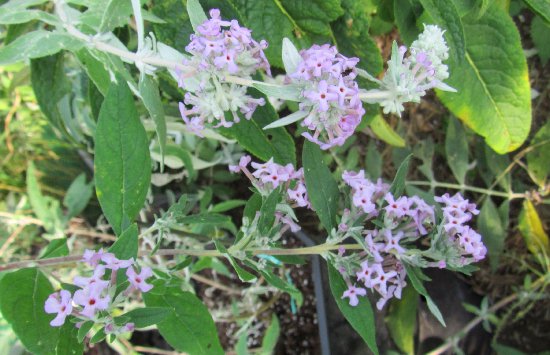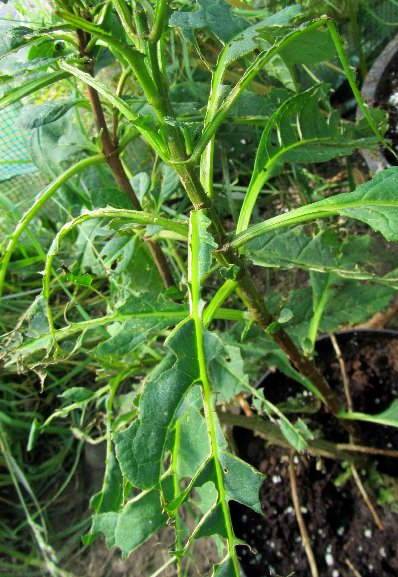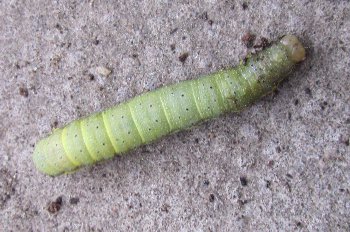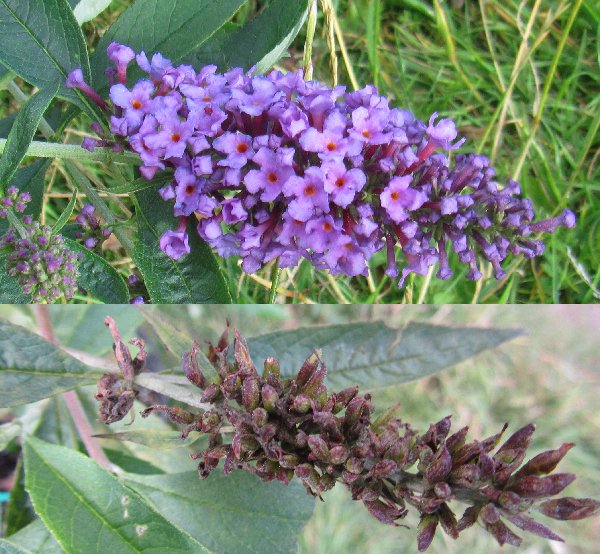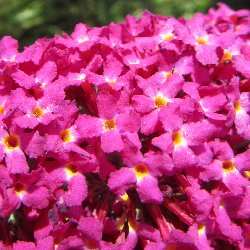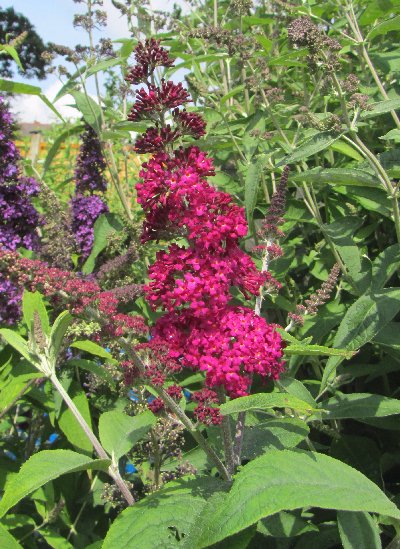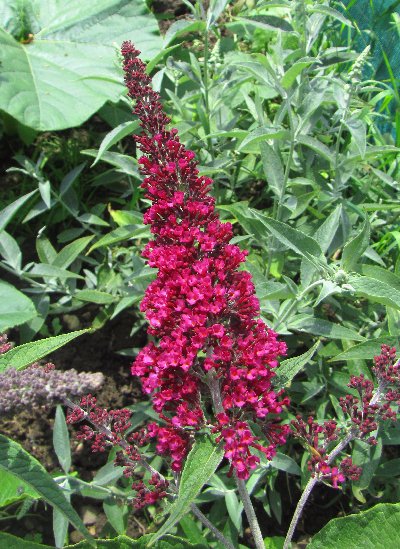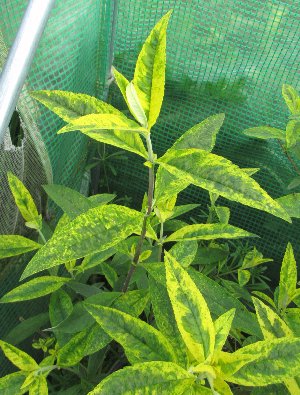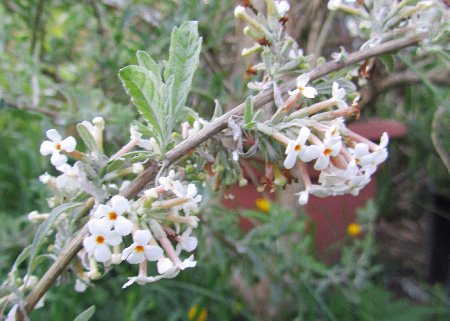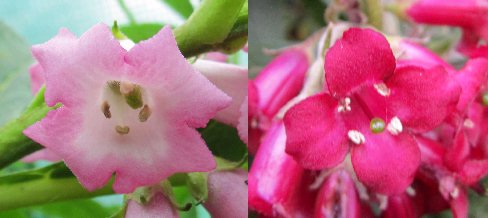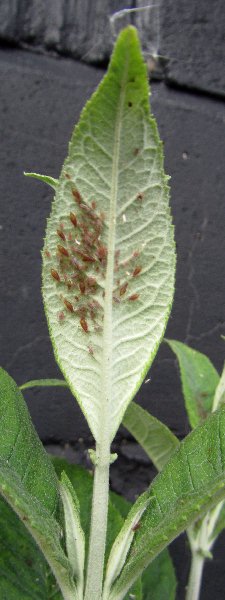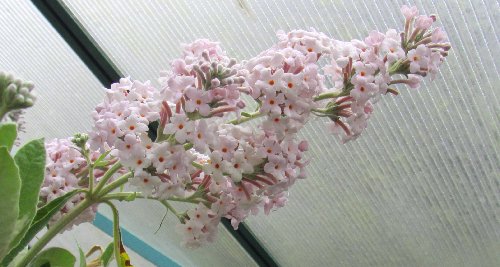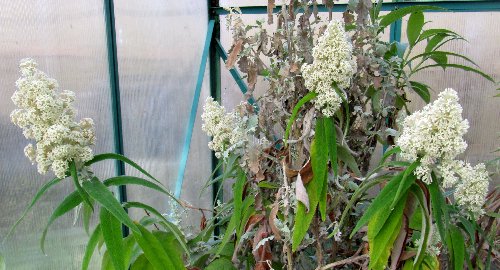
THE 2014 BUDDLEJA GARDEN CALENDAR
October 2014
Salmon Spheres is flowering its buds off now in early October. Having established itself as a huge plant outside it is really showing its potential and will be the last Buddleja in flower this season. The nights are a bit cooler now and the flowers are maturing, both of which contribute to the amazing two-tone effect of the blooms. Originally in September they were a dusky pink and now they are both pink and orange, the orange is a legacy of the B. Globosa heritage and the pink from B. crispa. I will trim the plant and tidy it up but will avoid any major pruning; I am looking forward to another show of flowers in the spring. After this it will have to be controlled before it swamps its neighbours. |
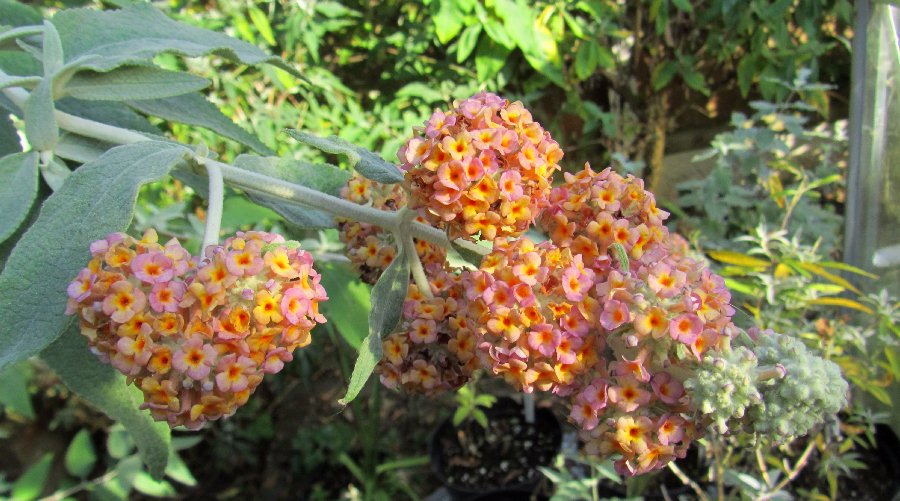
Salmon Spheres is quite striking this autumn. |
|
I have mentioned the cultivated form of B. caryopteridifolia a few times here, offering my opinion that it almost certainly isn't that species at all. Photos from China of the authentic B. caryopteridifolia (see in March below) confirm this belief. I think the plant is in fact a hybrid of B. alternifolia based on the frequent stems with alternate leaves as well as the scent of the foliage, a feature seemingly unique to B. alternifolia and its hybrids. The most likely hybrid partner is one of the many B. crispa types and the correct label for these naturally occurring hybrids is B. x wardii. I have been lucky enough to be loaned a B. alternifolia x B. crispa F1 hybrid seedling (thanks here to The Lavender Garden). The exact pollen parent is unknown but is one of the spring flowering B. crispa varieties, either B. sterniana or B. farreri. The flowers are remarkably similar to the spurious cultivated form of B. caryopteridifolia (that is probably B. x wardii) and the foliage, when rubbed, has exactly the same scent. The leaves are fairly similar but are crenate and more pubescent, features inherited from the pollen parent; they are also occasionally alternate or least offset. I am now convinced that the plant I have that is labelled as B. caryopteridifolia is in fact B. x wardii. Buddleja tsetangensis is being sold as B. wardii KR4881 (see May below), but this should not be confused with B. alternifolia hybrids, whether from the wild or a result of plant breeding. This B. tsetangensis cultivar is a naturally occurring plant that has not had its hybrid status confirmed. |
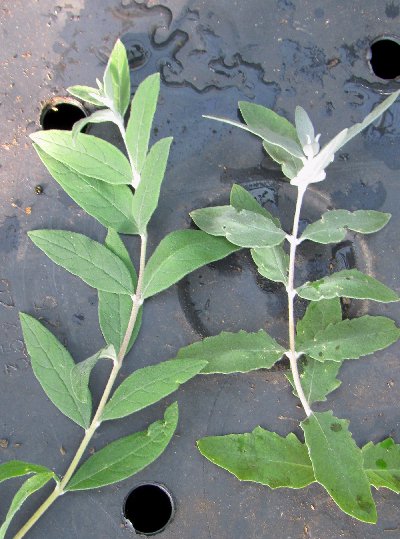 Above: the left stem is from the spurious B. caryopteridifolia, the on the right is the B. alternifolia x B. crispa F1 hybrid. Note that the leaves are often slightly offset rather than opposite on both plants. |
Buddlejas are usually problem free. However, I have already seen nematodes, spider mites and aphids infecting Buddlejas this year and autumn has brought another pest. Bright green and brown hairless caterpillars have been eating my plants, some outside but mostly under cover. Lacanobia oleracea (Brown-line Bright-eye) larvae, a very common Noctuidae moth, is probably the culprit. These 3cm long greedy eating machines can strip plants but this is the first year I have seen them go after Buddleja. The long warm summer has allowed them a second generation in the autumn and Buddleja are a tempting food source. They are pupating now so the damage should stop soon. Buddleja are robust and usually recover in spring.
|
It is the end of another growing season and there are jobs to do before the cold sets in. It is best to complete all the dead-heading now and generally tidy up. Tall plants of summer flowering Buddleja can be reduced in height now but the main hard pruning should be left until March or even April. Spring flowering species should not be pruned as the flowers buds are forming now, often visibly. Many of the more tender species Buddleja in pots will soon need to be brought back under cover and kept fairly dry for the winter. The less hardy species planted outside should be offered some protection from water-logging and hard frosts. The latent flower buds of the spring flowering species such as B. glomerata and B.officinalis are forming now; these are particularly vulnerable to frost and cold winds so using fleece may be advisable. |

|
More Buddleja news: there is yet another new series of smaller cultivars from Walters Nurseries in the USA, called the Monarch Buddleias (sic!). These have really terrible names: Crown Jewels (purple); Dark Dynasty (deep purple); Glass Slippers (pale blue); Jousting Jester (lilac); Princess Bride (white); Queen of Hearts (magenta); and Royal Falls (mauve). They add little new to what is already available and are something of a 'Me, too!' response to the plethora of new plants released in the USA. Don't expect them to released in Europe anytime soon. Well, that's another year in The Buddleja Garden. There will be a new look for the Buddleja Garden Diary when it returns next year. Rather than a full report each month I will add new stories as they occur, more like a blog. You can have a look at the new format HERE. |  |
September 2014
Last month I went on a bit about dead-heading B. davidii but this month I can offer evidence of the benefits of this chore. A few of my plants flowered quite early and had to be dead-headed by early August. Where I took the time to fully remove the spent flowers a second flush soon developed, nice late summer colour for me and essential autumn food for butterflies and bumble bees. For example, Shire Blue had a cloud of blue flowers, smaller panicles than the first flush in July but more numerous. Many of the newer hybrids re-bloom without the necessity of removing all the spent flowers, as they often form fewer or no seeds. I didn't dead-head Flutterby Lavender as I want to test the viability of the seeds that are forming but it has still put on a good second show. The colour isn't remarkable and paler then the first flush with a more obvious fading centre to the corolla. | 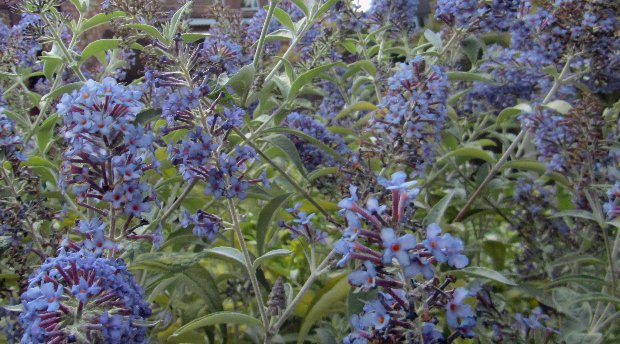 Shire Blue re-bloomed particularly well. |
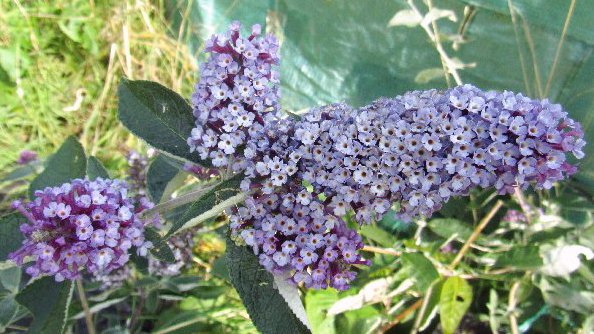 Above: Flutterby Lavender didn't need dead-heading to put on a second show.
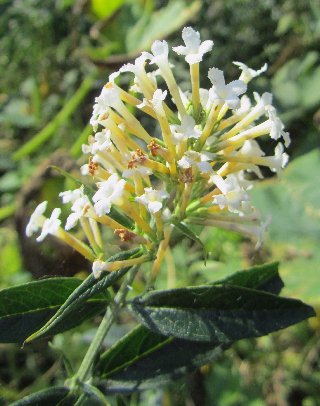
| Flutterby Petite Snow White (sold as Free Petite in Europe) has finally flowered. It is very like Flutterby Petite Dark Pink, small open panicles and a long corolla tubes, but very bright white. The plant is dwarf with an open habit, and the foliage is similarly small, deep green and glossy. The flowers are few in number and rather unimpressive. Autumn Beauty is not classified as B. davidii based solely on its aberrant phenology (the normal flowering-time is September) but it looks much the same and has no special attributes beyond the late flowering. It's a fairly average light lilac-pink but is still a useful plant for extending the flowering season into autumn. It crosses readily with B. davidii and forms copious fertile seed. Mine was only planted out in May so the flowers are still rather small. I have had trouble establishing Lo and Behold Blue Chip and have had to start a new plant, in a pot and under cover. Finally it looks healthy and has flowers, which are rather crowded on the panicle and look rather odd. It's not my favourite mini-Buddleja but I will try again to established one outside. Salmon Spheres has proved hardy and a bit of a monster several metres high. Excellent soft grey foliage and globular pink-orange flowers. Best of all it flowers both spring and autumn, so I can forgive it vigorous and unruly habit. It's best planted against a warm south facing wall as it does requires shelter to perform well outside. 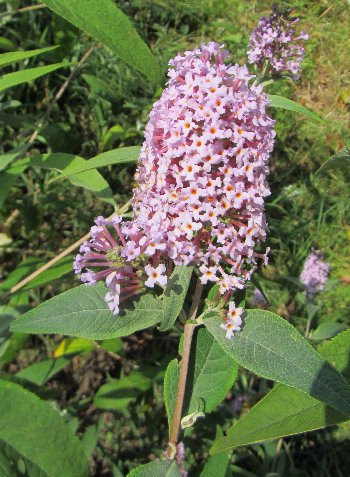 Autumn Beauty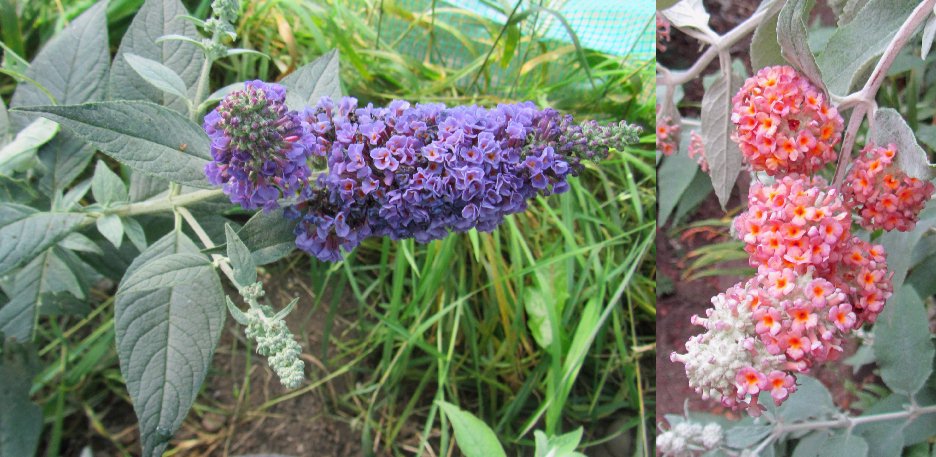 Lo and Behold Blue Chip (left) has very crowded panicles. Salmon Spheres (right) has flowered for the second time this year. | ||||
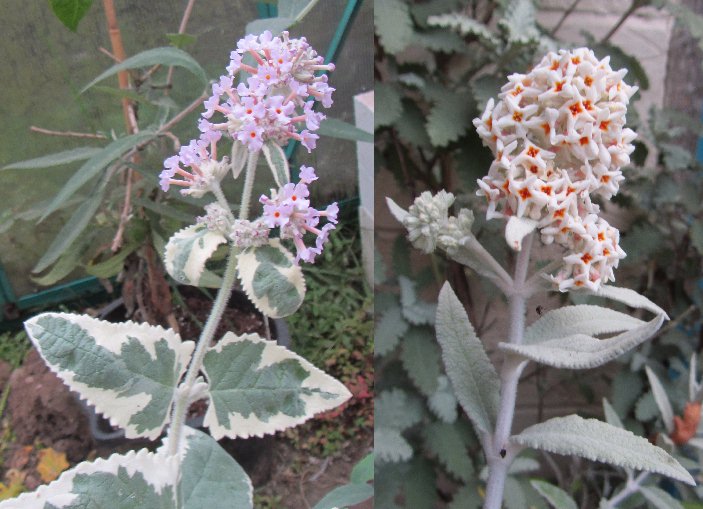 Buddleja crispa Stone House Cottage (left) and Silver Anniversary (right) in flower. | Silver Anniversary (syn. Morning Mist) managed to flower earlier in the year (see June below) because of the mild winter, and the warm summer has allowed it to flower again at its normal time. Here in the Midlands it has struggled to put on enough growth to flower some summers but it is more of a foliage plant anyway with such intensely silver foliage. In June I saw an amazing variegated cultivar of B. crispa at Stone House Cottage Garden and the small plant I obtained at the time has now flowered. They are naturally no different to the non-variegated plant but it is a good sign of reasonable vigour in the cultivar that it is able to develop these normal inflorescences. I have struggled to keep the summer-flowering B. crispa alive in the past, and I will have to pay special attention to this variegated form as it may be even less tolerant of damp conditions. |
On a different subject: I kept all sorts of seeds last year, including from B. albiflora x B. davidii hybrids, B. limitanea and B.nivea all kept together in a single poly-tunnel. B.nivea seems very promiscuous as most of the seedlings are coming up rather hirsute with white tomentum on stems and leaves. They don't seem too robust and may not make the winter; it is anybody's guess as to what the flowers may look like or whether they will ever flower at all. The B. nivea seedlings also unsurprisingly look like the parent plant and only the flowers will tell if they are the result of self-pollination or hybrids. Right: (B. albiflora x B. davidii) x B.nivea possibly? | 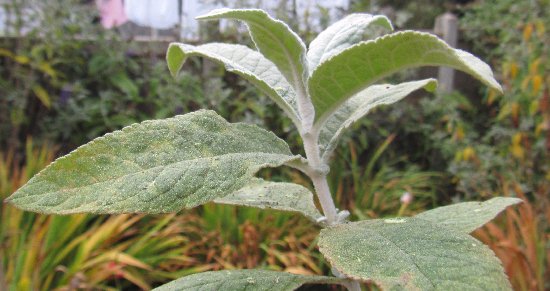 |
I was able to pay a visit to Crûg Farm Plants on the North Wales coast during September. Sadly most of the Buddlejas had finished flowering and I forget to take my camera so no photos of my visit. Despite the lack of flowers the visit was fascinating. I saw a remarkable array of Buddlejas sheltered in the wooded garden and benefiting from the maritime climate, many from seed collected in the wild and unique to this nursery, including various B. colvilei and B. forrestii cultivars. With the latter species cultivars varied from smallish shrubs to small trees. A particularly interesting plant was Buddleja paniculata GWJ9286* from Sikkim, growing quite happily outside and resembling a smaller B. officinalis. Next time I must go earlier in the year. My thanks to Bleddyn Wynn-Jones for taking the time to show me around. (*Note - This plant is in fact B. macrostachya.) |  |
August 2014
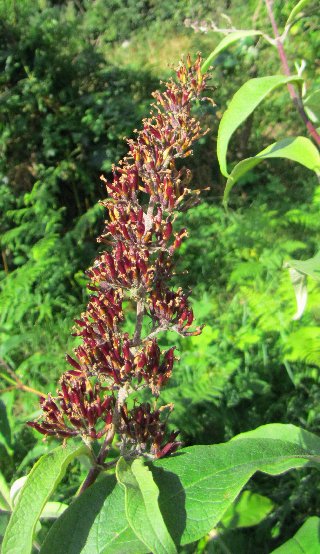
A seed-head of a B. albiflora hybrid with red-pigmented capsules. |
After such a perfect warm July August has been disappointingly cold. The dry, hot weather in July has made many of the B. davidii cultivars finish flowering already and there is much less to see this month, unless you find the seed-heads interesting. Worse still, tedious job of dead-heading must begin now. There are so many reasons to dead-head your Buddlejas: it looks so much tidier; most cultivars will then produce an autumn flush of flowers; the plant saves energy and nutrients by not producing copious seeds; and you don't get all those annoying seedlings popping up next spring. DEFRA (the UK's Department of Environment, Food and Rural Affairs) has rather taken against the beloved B. davidii lately and has been describing it as an alien invasive species. This is despite the fact that it is not included in Schedule 9 if the Wildlife and Countryside Act so is not a real baddie like Japanese Knotweed. Their problem seems to be the ability of seeds to disperse and grow almost anywhere, which is patently untrue: they may like demolition rubble but would never grow on open farmland, for example. Current advice is for gardeners to dead-head their Buddleja to prevent its spread. Of course our domestic Buddlejas are a drop in the ocean compared to the feral population allowed to grow by lazy agencies such as Network Rail or brownfield landowners, and they certainly never go to the trouble of removing seed-heads.
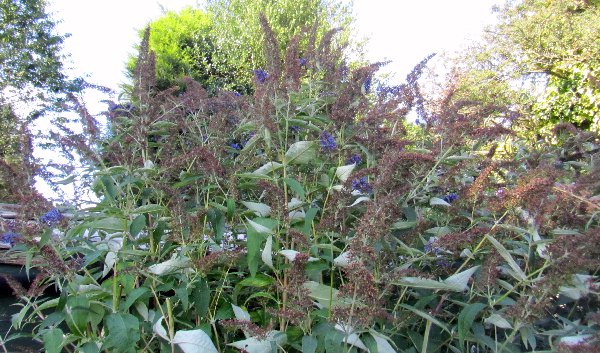
This mess of spent flowers should be attended to. |
Pink Pagoda is a seedling of B.x weyeriana Sungold and has the advantage of never setting seed. It is also slightly later flowering than many of the other cultivars and like the B.x weyeriana cultivars is greatly favoured by bumblebees, although butterflies also feed on these when the B. davidii have finished.
| 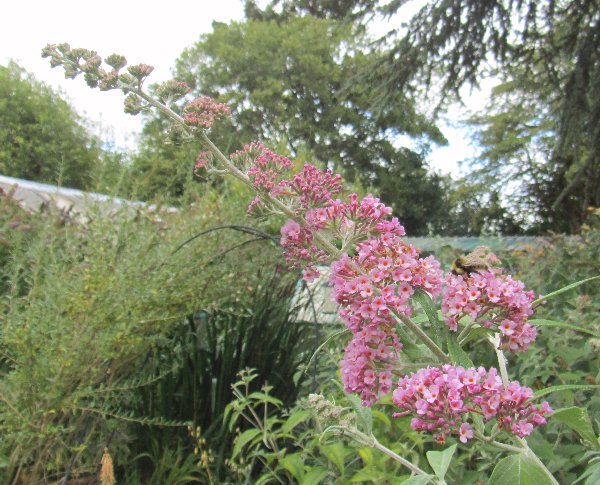 |
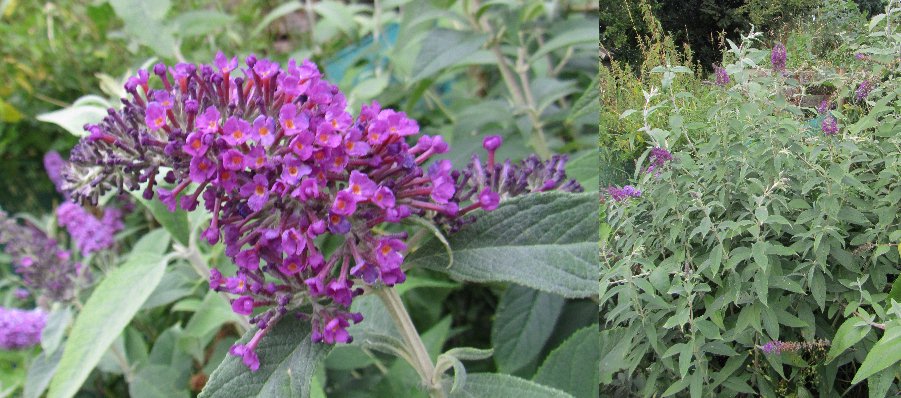
Lo and Behold Purple Chip is flowering now (left) but has grown much more upright than expected (right).
Flutterby is another series of hybrid Buddleja from the USA that is sold on its low fertility. Many of them are now available in Europe, some under the Free Petite trade-name. Flutterby Lavender, Peace and Pink (all medium size plants) flowered earlier in the season, but are repeating now. All three should have low fertility but all of them have numerous seed capsules. Flutterby Petite Blue Heaven (one of the smaller plants) has also produced seed capsules. I will collect the seeds and check their viability. The flowers of some of the Flutterbys are rather disappointing, for example Peace is an average purple-mauve colour and the flowers very small; it is also very slow growing. The very diminutive Flutterby Petite plants (these are called Free Petite in Europe) Petite Dark Pink* and Lavender Flow both result from the hybridisation of B. davidii and B.alternifolia, and they have a very low, spreading growth habit with small narrow leaves. Lavender Flow has unremarkable flowers. It is so lax it can be grown in a hanging basket. Dark Pink's* flowers are rather strange: the panicles are very open and the corolla tube is very long, different but not very attractive. And the colour is fairly insipid. (*Note - I have recently identified this plant as Podaras #7 Flutterby Flow Mauve Pink; the correct plant Podaras #10 is now available in the UK.) | |
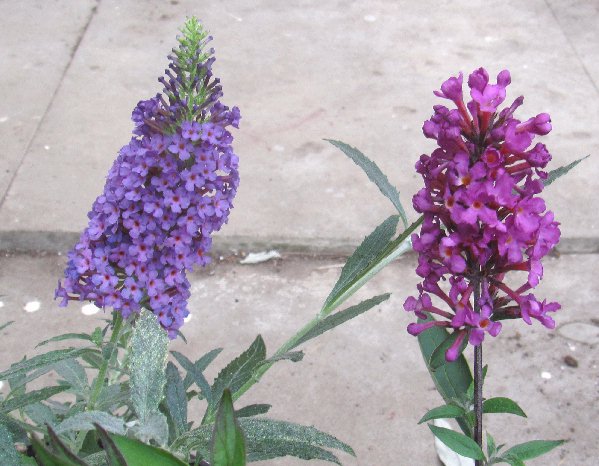 |
Flutterby Petite Tutti Fruitti is also a small stature plant more upright in habit. I have only just received a small plant; the leaves are small and narrow, the flowers are a vibrant plum-pink and the individual flowers large like Flutterby Petite Blue Heaven (so far the star of the Flutterbys), and certainly larger than many of the dwarf B. davidii cultivars such as Buzz Sky Blue. It took me three attempts to get an authentic example of Tutti Fruitti and had spent several months raising two "cuckoos" that turned out to be Buzz plants. I am loosing count of the number of wrongly labelled plants I have received, including the erroneous B. farreri (actually B. agathosma) described in April this year (see below). It's not so much the cost of the plant, rather the time spent tending the wrongly identified plants that then have to be discarded.
Buzz Sky Blue (the flower on the left) compared to Flutterby Petite Tutti Fruitti (on the right). |
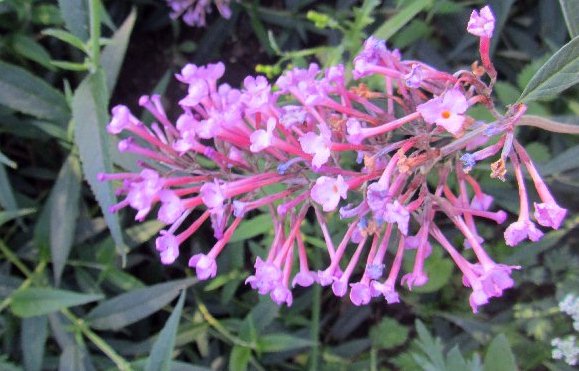 Flutterby Petite Dark Pink* has fairly small, narrow foliage and unusual flowers with a very long corolla tube. | 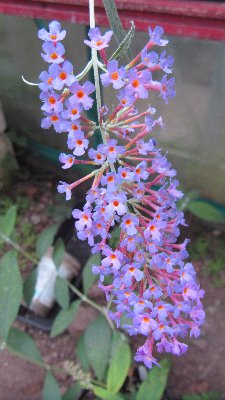 |
LEFT: Flutterby Petite Lavender Flow has open, lavender flower panicles and a very lax habit. |
July 2014
July is the month when things really begin with the Buddleja davidii cultivars and hybrids. July is a little early for many species of butterfly as the new generation has yet to emerge. They are still caterpillars, eating machines that will soon pupate. Buddlejas may help the adults but you should also have a nettle patch for the caterpillars, as this is a food plant for several species. The Peacock butterfly is one of the most spectacular but the larvae are ugly and mostly black and their favorite food is nettle leaves. I am currently growing a few of the new Flutterby hybrids, bred by Peter Podaras in the USA. I can't say I am impressed by some of them but a couple are noteworthy. Flutterby Petite Blue Heaven is a very nice plant with medium blue flowers, unusual toothed foliage and a well-branched habit. The individual flowers are larger than normal and have a white ring in the centre. Very low seed set and a diminutive size of no more than one metre are promised. What I find most remarkable is that it is an F2 hybrid from a cross of B. davidii and B. alternifolia. | 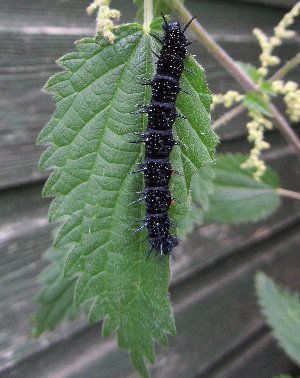 A Peacock Butterfly caterpillar eating nettles. |

Flutterby Petite Blue Heaven is the star of the series.
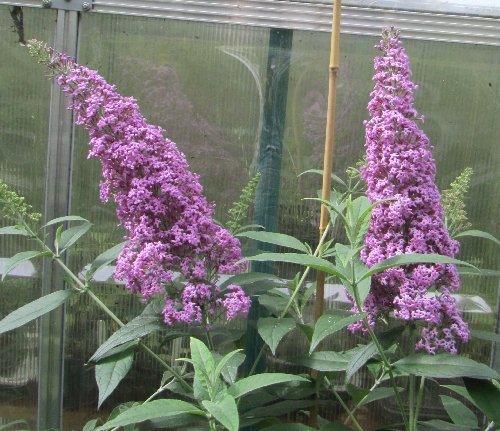
Flutterby Pink has very big panicles.
The Flutterby Grande have not been introduced into Europe, which is pity as several look quite unique. It is possible that the interesting orange flowered Flutterby Grande Tangerine Dream and Sweet Marmalade would not survive the wet UK climate, which may explain why they have not been brought over. Flutterby Pink is one of the medium size plants (up to 1.2 metres) that has been brought over along with Lavender (reviewed last month) and Peace (thus far this hasn't grown enough to give a fair assessment). Pink is an upright grower that produces huge flower panicles. They aren't what I would call pink, more of a lilac-mauve. But they are certainly impressive at over 40cm in length and very fat. Although a pure bred B. davidii it still has very low fertility like the rest of the series.
More on the whole Flutterby Series
This isn't the only cultivar with such impressive flowers. Gulliver is a recent intoduction that has incredibly fat panicles, like lilac clouds. Billed as a small shrub but mine has grown bigger than expected, well over 2 metres. Reve de Papillon Rose hails from France and this also has great big flowers, in pink. I can see that it has some relation to Pink Delight but the colour is not as pure a pink, tending more towards lilac. There are also a Reve de Papillon Blue and White that I haven't seen yet.
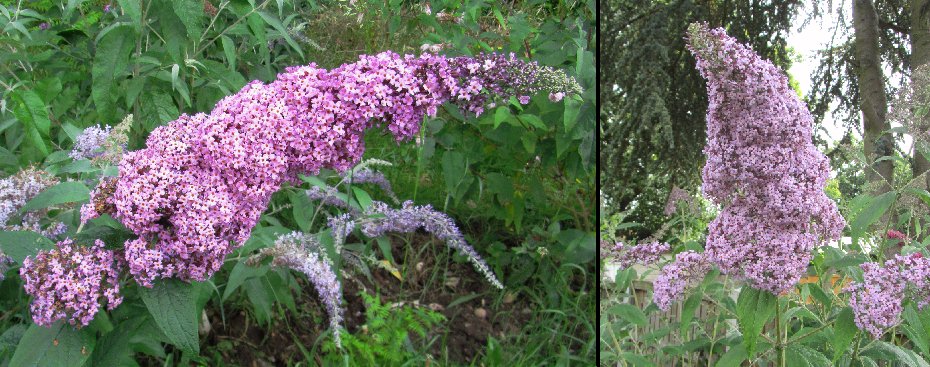

Flutterby Petite Blue Heaven is the star of the series.
The Flutterby Grande have not been introduced into Europe, which is pity as several look quite unique. It is possible that the interesting orange flowered Flutterby Grande Tangerine Dream and Sweet Marmalade would not survive the wet UK climate, which may explain why they have not been brought over. Flutterby Pink is one of the medium size plants (up to 1.2 metres) that has been brought over along with Lavender (reviewed last month) and Peace (thus far this hasn't grown enough to give a fair assessment). Pink is an upright grower that produces huge flower panicles. They aren't what I would call pink, more of a lilac-mauve. But they are certainly impressive at over 40cm in length and very fat. Although a pure bred B. davidii it still has very low fertility like the rest of the series. More on the whole Flutterby Series This isn't the only cultivar with such impressive flowers. Gulliver is a recent intoduction that has incredibly fat panicles, like lilac clouds. Billed as a small shrub but mine has grown bigger than expected, well over 2 metres. Reve de Papillon Rose hails from France and this also has great big flowers, in pink. I can see that it has some relation to Pink Delight but the colour is not as pure a pink, tending more towards lilac. There are also a Reve de Papillon Blue and White that I haven't seen yet. |
Reve de Papillon Rose (left) and Gulliver (right) also have abnormally big flower panicles.
I have heard a lot of positive comments about the new bright pink-red cultivars and the colours are truly stunning. Miss Ruby appears brighter to most people, brighter than Miss Molly (Red Chip), Sugar Plum and Buzz Red, even though the basic colour-shade is the same. It is a simple trick of the eye, literally. Whereas all the others have a fairly uniform corolla (petals) Miss Ruby has a very distinctive patch of white at the base of each petal, forming a second ring to the eye. This is invisible from a distance but makes the whole panicle appear just a little brighter. There is not much to choose between all these plants, all have their good points but for my money Sugar Plum is the best choice because it grows like a traditional cultivar and has the deepest colour. |
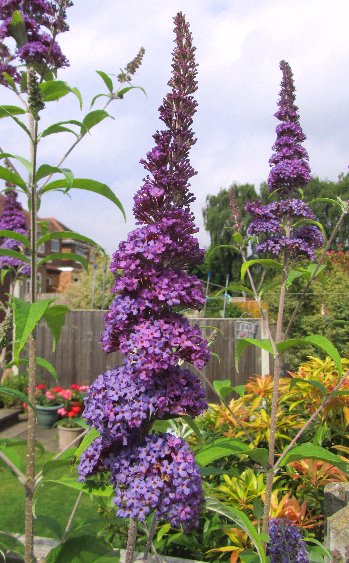 This Pink Delight seedling has fine upright flowers that change colour. |
A few years ago I was smitten with the idea of two-toned flowers, or what I tend to call mosaic flowers as the individual florets in differing shades are a bit like tiles in a mosaic. Two Tones from The Lavender Garden was one of the first I had seen. But I have now seen so many that I have tired of the effect. I have raised seedlings from the open pollinations of Pink Delight and Summer Beauty, the closest neighbours to the seed parent often being blue cultivars. The result has been flowers that often open deep purple but then gradually fade to blue. Sometimes the fade is random and the whole flower is a mosaic of the two colours (such as Two Tones), more often the colour changes with age and the flowers become blue at the base and purple where newly opened. I also see this effect in quite a number of feral Buddleja, particularly the purple ones. Unless the effect is dramatic, such as in Bicolor (Flower Power) that changes from purple to bronze, I don't see the appeal any more. The cultivars that have stood the test of time are those with strong, consistent colouring. 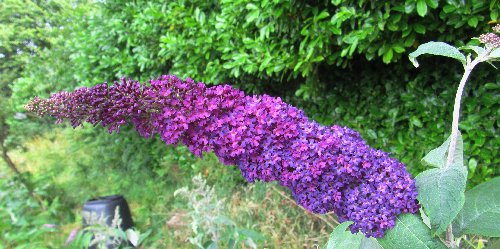 The colour change can be quite ugly such as on this Summer Beauty seedling. |
 Colour Fountain Blue is tiny. | Colour Fountain Blue from Thompson & Morgan, also called Foot Long by Van Meuwen, has taken a while to establish but finally I have a plant growing outside and flowering. Blue is a bit of a stretch as it is a lilac-lavender colour and the flowers are rather less than 30cm long. But it is a very sweet little plant less than 50cm tall with narrow leaves. I believe it is a pure-bred B. davidii unlike several of the Flutterby Petite series, but even so it is similar in growth habit to several of the B. davidii x B. alternifolia hybrids such as Flutterby Lavender Flow, Snow White and Dark Pink. Colour Fountain Blue arose accidentally out of the Buzz breeding programme and is so far on its own, but I understand that more Colour Fountain cultivars may follow into an already over-crowded marketplace for mini-buddleja. July has been a bumper month, who knows what August may bring? |
June 2014
There's nothing so encouraging as a few warm days and June has been reasonably warm with just the right amount of rain. Everything is now increasing fast, some Buddlejas are almost visibly growing. Buddleja globosa tends to flower reliably around May and the beginning of June, irrespective of the weather. As a species that evolved at altitude, where the weather can be unpredictable, day length rather than temperature is the trigger for flowering. It is a big, vigorous shrub and mostly evergreen. After six years my main plant is 5 metres high and as wide. I can't accommodate more full size specimens so my others are still in pots. B. globosa has separate male and female plants (dioecious) but this is difficult to appreciate as the flowers of both look more or less the same (cryptic dioecy). I have had the opportunity to compare the flowers of several different plants this June and have found that only one is female and three male. I have pulled apart several flowers and looked at them with a hand lens. The female had only withered, vestigial stamens (male organs); conversely the males still have a very visible stigma (the tip of the female organ) but never go on to produce seeds. The sessile stamens are quite hard to see in many flowers as they tend to be the same colour as the petals, for example in HCM98017 and B. araucana (a close relative). I was very pleased to finally get a B. globosa seedling to maturity, as they are a bit temperamental. The seedling?s flowers are slightly different in having a reddish centre and they also have very visible white stamens, which really helps show the structure of the flower. More on Buddleja globosa. | 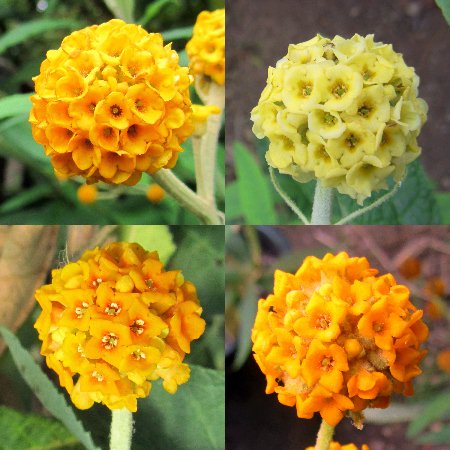 B. globosa female (top left), the male HCM98017 (top right),
|
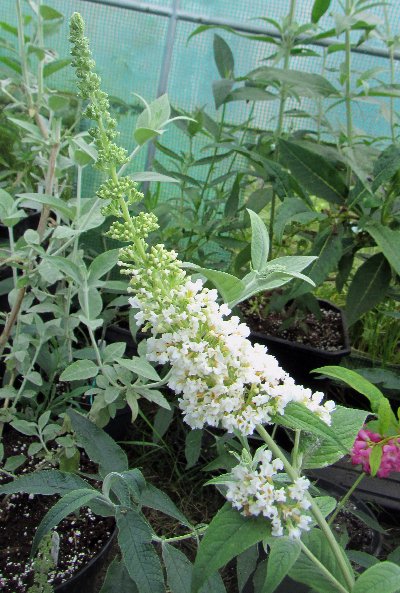 Lo and Behold White Chip |
Many of the B. davidii cultivars and hybrids are forming flower buds and some have even opened in June, but more on these next month. You can delay flowering by pruning later than March, if you want a late August display pruning can be left until mid May. I prune mine in March because I am impatient to see the flowers. Some of the new hybrids are billed as blooming before the traditional cultivars and indeed Lo and Behold White (Ice) Chip and Red Chip (syn. Miss Molly) have obliged by having their flowers open by mid-June. White Chip is a small plant very like Blue Chip in size and foliage. The flowers are a bit odd: they are rather raggedy as the petals don't hold open to form the usual flat face. Red Chip is a fine colour and similar to Miss Ruby (its parent) except it is a more diminutive plant with larger flowers a shade deeper. Still far from the Sangria Red the publicity claims, but a remarkably deep cerise none the less. 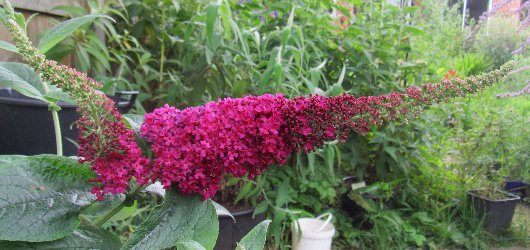 Lo and Behold Red Chip, also called Miss Molly |
Flutterby Lavender is another new semi-dwarf cultivar that is part of a a series of fifteen new Buddleja (see the Podaras Hybrids Page). It has also flowered early and claimed to be near-sterile; it's a hybrid of B. davidii and B. alternifolia, although there is little evidence for the latter species' genes. I have to say that the colour is unremarkable. I can't yet comment on the growth habit but it is described as forming a compact bush about 1.2 metres (4 ft.) in height and spread. Morning Mist (syn. Silver Anniversary) normally flowers late summer but this year's mild winter (and my forgetting to prune it) has allowed it to have a few flowers earlier in the year. It is a hybrid of B. crispa and B. loricata, both these species are in flower now. This is an opportunity to compare the flowers of Morning Mist and B. loricata: they have very similar flowers but, as with the leaves, Morning Mist's are much softer; the scents are similar, but whereas B. loricata has a clean citrus scent with some spice Morning Mist has a much more heavily spiced aroma over the citrus scent. The main contribution from B. crispa in the hybrid is the very soft felted grey foliage. | 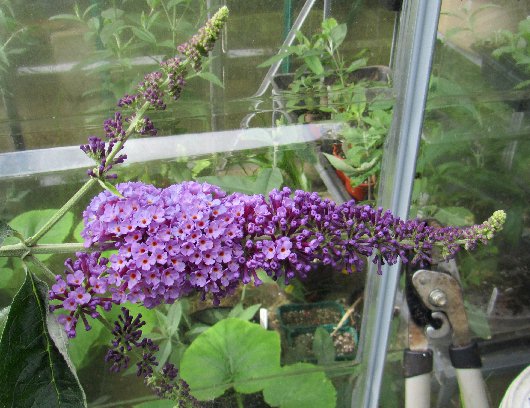 Flutterby Lavender has flowered early. |

Buddleja loricata (left), compared to the hybrid Morning Mist (right).
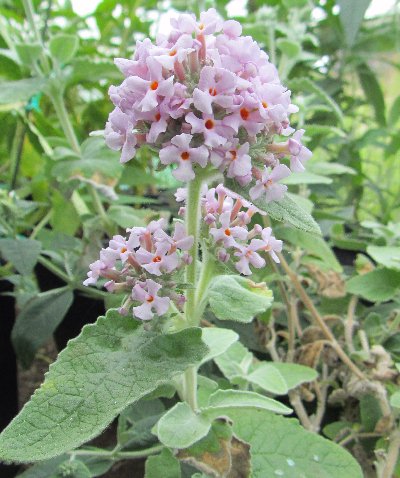 Buddleja crispa in flower.Whilst on the subject of B. crispa: I came across a real treasure at Stone House Cottage Garden in Worcestershire: a variegated sport of this species! The variegation is beautifully regular with wide, white leaf margins. The plant is currently named Buddleja crispa Stone House Cottage and should be available for sale from this excellent garden and nursery next year. | 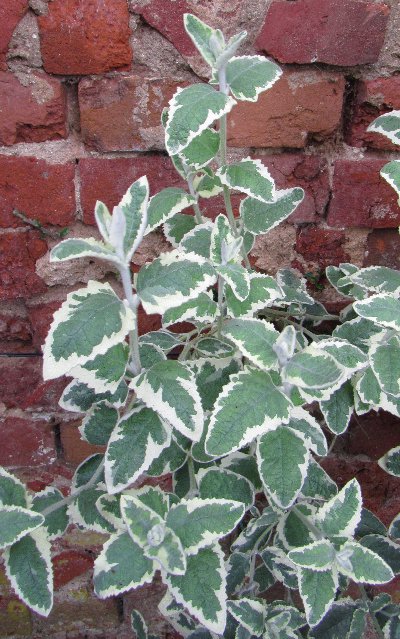 Buddleja crispa variegata 'Stone House Cottage'. |
After all those new cultivars and hybrids in the past months it is refreshing to be able to report on a newly described natural species in Shannxi Province, China. Buddleja jinsixiaensis is morphologically similar to B. delavayi but has delicate blue flowers with a white eye. Ref: Zhu, R. B., Kang, B., Cheng, J., Zhang, B., & Zhao, X. (2014). Buddleja jinsixiaensis (Scrophulariaceae), a new species from Shaanxi, China. Phytotaxa 159 (4):291?294. | |
May 2014
|
Spring has come earlier than last year, but there has still been some very cold nights in May, despite the warm days. Buddleja davidii cultivars are all over the place in terms of development, dependent on location, pruning and variety. I have everything this month from those just coming back into leaf to those already forming flower buds, the latter not always because they have been over-wintered under cover. I am hoping that will mean a succession of flowers all through summer and autumn, from late June to October. Following on from last month's discussion of yellow and variegated foliage, I really doubt that B. davidii Sir John represents a genuinely separate cultivar from Santana, as they have identical flowers. True, the pattern is less regular than the usual Santana variegation, but then Santana is so variable that Sir John's foliage easily falls within this variability. However, that doesn't mean that the foliage can't be spectacular and in the recent warmth under cover the yellow foliage has become very bright indeed. Buddleja x weyeriana Variegata (also once known as Flights Fancy) also has remarkable foliage this spring. In summer it has been predominantly green with yellow speckles on the leaves but at the moment yellow dominates. It is a sport of Sungold but the exact mechanism of variegation is unknown, possibly caused by a harmless virus. | |
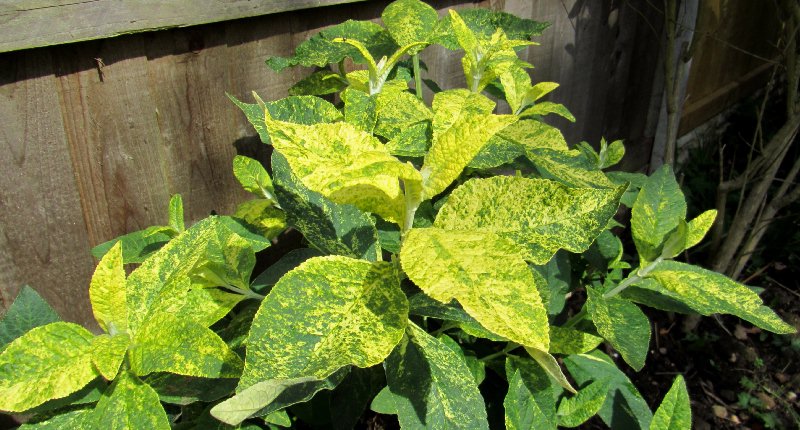 B. x weyeriana Variegata is looking good. | |
Buddleja tsetangensis is a relatively new species to the UK and is being sold as B. wardii KR 4881, B. x wardii being a naturally occuring hybrid of B. alternifolia and B. crispa. I have seen a few such hybrids now and it really doesn?t show much evidence of any B. crispa heritage. Essentially it is a white flowered, grey-leaved variant of B. alternifolia and I would hazard that the correct botanical description should be B. aff. alternifolia KR 4881, as B. tsetangensis is officially sunk as a synonym. It has flowered in May with flowers in a pattern similar to alternifolia but opening slightly earlier, and with a differing but very pleasant scent. The leaves, though, have exactly the same scent as B. alternifolia when crushed. Unusually, it kept much of its foliage over this winter even though normally I would expect it to be deciduous. |
|
Other species and hybrids in flower now include B. colvilei, both the red Kewensis and the pink-flowered form. I lost my pink B. colvilei two years ago, probably due to root rot or vine-weevil grubs. But the cuttings taken from the dying, wilted plant have now grown into healthy small specimens. The flowers are much bigger than any other Buddleja species so you can really appreciate the flowers' structure. Others in flower now include B. glomerata, B. salviifolia (blue form) and the plant labelled as B. caryopteridifolia. The hybrids Salmon Spheres and Silver Anniversary (also known as Morning Mist) are flowering now. Silver Anniversary would normally flower late summer but the flower buds have been held dormant all winter in the mild conditions whereas normally they would be destroyed by the frosts. | |
 B. colvilei pink-flowered form (left) and Kewensis (right) are in flower. | |
|
Buddleja are tough and resistant to many pathogens when fully-grown and healthy. A few diseases and pests can affect them. This year I have been cursed by a swarm of brown aphids on many young plants, tentatively identified as the potato aphid (Macrosiphum euphorbiae). These are unfussy feeders and attack hundreds of plant species. I hope they will soon move on but for now I am rubbing them off by hand. They are not that damaging but can be a vector for plant viruses and they are very unsightly. Much more serious is the microscopic Chrysanthemum leaf and bud nematode Aphelenchoides ritzemabosi. Again most full-grown Buddlejas are safe: mostly it is cuttings and young plants that can suffer and die. The nematode only rarely infects the buds, which causes distortion and stunting. The leaves are colonised, with infected sections between the minor veins showing up as yellow patches that eventually turn brown and dry. I have found that B. globosa and B. x weyeriana are particularly prone to this pest. Also the very wet summer of 2012 was perfect for the multiplication of this pest, as they thrive in wet conditions able to move from leaf to leaf. There is no real treatment available to gardeners and generally it is advised to destroy infected plants by burning. I personally would not always do this, as the infection is often only temporary. Keeping a plant hot and dry can really help clear the nematodes in a greenhouse. Adult Buddleja growing outside mostly have dense enough leaf hairs to prevent the free movement of the nematodes as they have to move around the surface of the plant; they cannot move through the plant's vessels. But where the infection remains persistent and systemic destruction does seem the only option. 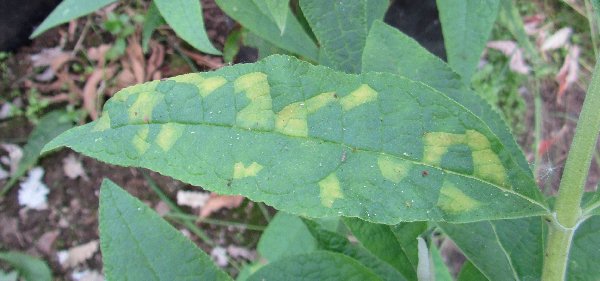 A leaf showing the typical yellow patches between the minor veins caused by nematode infection. |
|
The endless stream of new cultivars continues in the USA. New from Wayside Gardens is a series called Blooming Butterflies, low growing and suitable for hedging. There are five of them named: Blue Morpho (blue-lavender); Plum Judy (deep pink); Jezebel (bright purple); Painted Lady (mauve-pink with yellow foliage); and Great Southern White (white). Whether these are all entirely new plants or renamed European cultivars I cannot say. |
April 2014
|
Spring is here and no repeat of last year's April snow - hurrah! The mild winter means a bumper crop of spring flowers from all those exotic Buddleja species and hybrids that can be so shy to flower following a harsh winter. For the first time Winter Sun has flowered in my garden. It is considered fairly tender as it is a hybrid of B. officinalis and B. araucana, but I took the risk of planting outside. The flowers are a little like Salmon Spheres but rather more interesting - they are mixed shades of buff and purple. I suspect the colours might be different in a warm greenhouse, like Salmon Spheres and perhaps a little more pink under cover. But it is a great result, none the less. But would it have survived a harsher winter? Meawhile, under cover: Buddleja officinalis has flowered after last year's failure, plenty of pretty pink flower panicles but with only a slight scent; Buddleja salviifolia Alba also flowers now and the large creamy-white panicles have an amazing scent that fills the greenouse and, if you leave the door open, the surrounding area too. The blue form of B. salviifolia never flowers until a month after the white form making it hard for them to cross pollinate. |
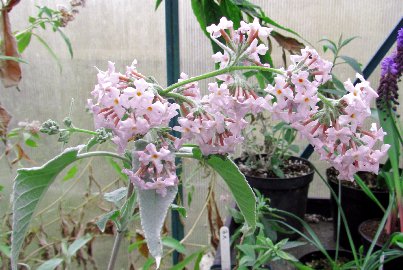 Buddleja farreri* flowers on nearly bare stems. | |
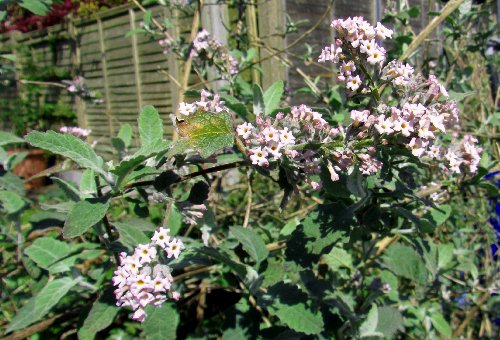 Buddleja sterniana has flowered really well this spring, outside and without any protection. | A new species in my collection is Buddleja farreri (note - since identified as B. agathosma), an Asian species described as hardy in the UK. This is one of several putative subspecies of B. crispa, although this is somewhat disputed. Mine is a rather small and weedy specimen but has produced rather attractive and sweetly scented flowers although almost devoid of foliage at the moment; the summer leaves are large, toothed and grey-felted. . The individual flowers are much greater in diameter (about 11mm) than B. crispa (summer flowering) or B. sterniana (about 7mm diameter). B. sterniana will also flower during April as does B. agathosma, another very similar species included in the B. crispa group with even larger and more heavily felted leaves. My B. sterniana is growing well outside and has produced many perfumed flowers, unlike last year's disapointmenting show. |
|
Many of the variegated Buddleja davidii cultivars derive from Royal Red including the popular Harlequin and Santana, and all their flowers share a slightly varying shade of maroon. Santana is a well-established variegated cultivar that has yellow foliage with a green centre. It has picked up alternative names such as Red Admiral and Sultana. Sir John is nearly identical but for a slightly more random variegation pattern to the leaves. Leela Kapila also has maroon flowers but fully yellow foliage and I would guess that Leela Kapila is a sport of Santana. My Santana plant is producing several fully yellow shoots and I see more Santana shoots become fully yellow than I ever see reversion to fully green. I will try to propagate these yellow sports but I suspect they may be rather weak and fail to root. Right: Santana produces all yellow foliage on some shoots.
| 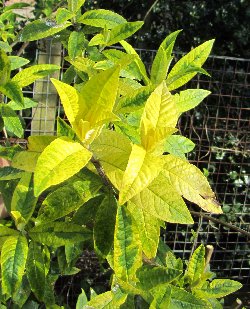 |
This is because there is a price to pay for variegated or yellow foliage. Royal Red has more intensely coloured flowers than Santana, and Leela Kapila has slightly paler maroon flowers in turn. The overall vigour is also related to leaf type - Royal Red is much more vigorous than Santana, and Leela Kapila stays very small compared to Santana. This due to the yellow chloroplasts being so much less efficient at photosynthesis that the usual green ones. Moonshine is a more recently released pink-flowered cultivar unrelated to the Royal Red or its variegated sports mentioned above. It does have similar all yellow foliage to Leela Kapila and it also stays rather petite. The foliage really stands out in the spring when there is so little other colour about. Right: Moonshine has foliage that stands out. | 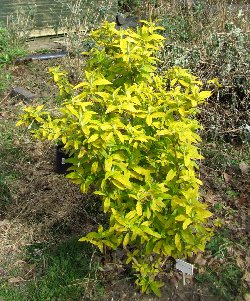 |
March 2014
|
Spring will be here soon and all the pruning, planting out and re-potting can proceed. Pruning is best left to the end of March for most areas of the UK. If pruned too early the new growth can be damaged by hard frosts. There is a handy pruning guide for B. davidii in the drop-down menu at the top of the page. Other species and hybrids that can be pruned now include B. albiflora, B. nivea, B. x weyeriana and B. fallowiana. Many of the other species are spring flowering and these should never be pruned until after flowering. Hopefully, there will be many interesting things to see during March and April. Let's hope there isn't a repeat of last year's March snow and cold April, although some plants are showing promising signs that it could be an early spring. Buddleja alternifolia is already waking up at the end of February, a full eight weeks earlier than last year. Buddleja 'Winter Sun' is considered a fairly tender hybrid but mine is so much happier outside in a very sheltered position. It hasn't been challenged by a really cold winter and is forming its flower buds now. These could be so easily lost if the weather turns very cold. 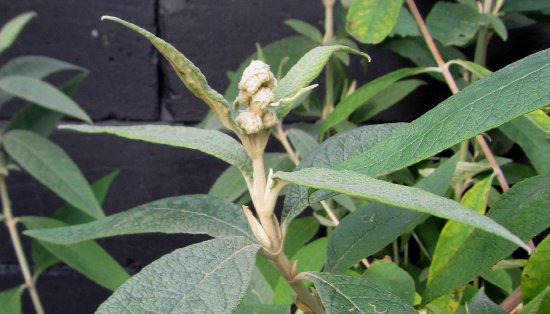 Buddleja Winter Sun has formed flowers buds over the mild winter. | 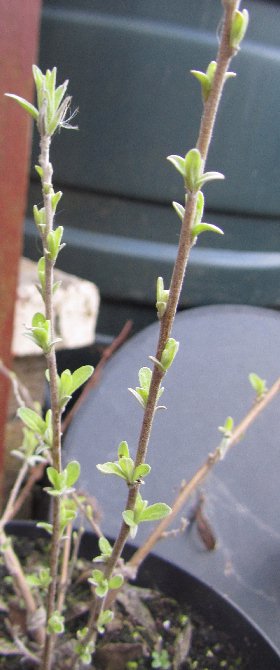 Buddleja alternifolia is already waking up. |
|
Meanwhile, some Buddleja news. The endless stream of new dwarf cultivars continues. There is another addition the Buzz range from Thompson & Morgan and available now. This one promises to be the darkest yet, a dark blue to purple. In the UK it will be known Buzz Indigo and elsewhere as Buzz Midnight. There could well be yet more Buzz plants to follow. And continuing on with the diminutive Buddleja theme: two additions to the Lo and Behold range: Pink Microchip and Blue Chip Jnr.. The former adds bright pink to the series and the latter promises to be an improvement on the original Blue Chip with better foliage and less brittle stems. | 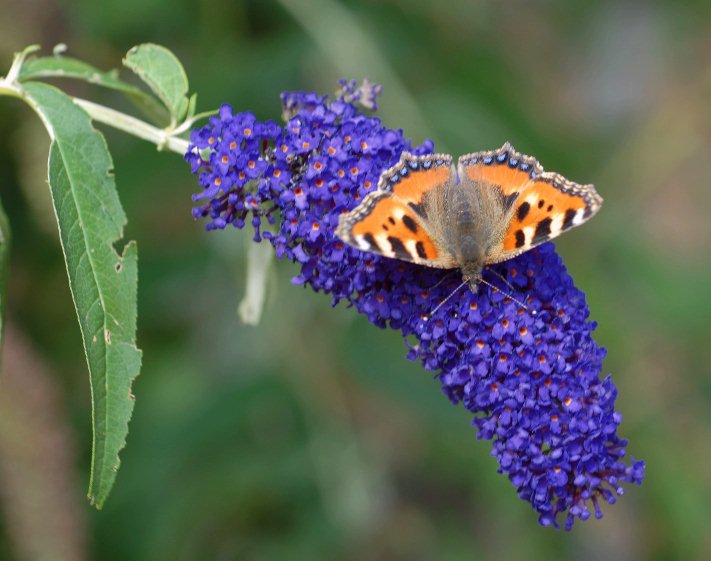 Buddleja Buzz Indigo: just released by Thompson & Morgan (photo courtesy of T&M). |
There are several new Buddleja davidii cultivars from Mike Dirr in the USA with curious names: Groovy Grape (purple), Psychedelic Sky (mauve-blue) and Funky Fuchsia (pink). They are part of the First Editions Range and available in the USA. Bright, intense colours and a dense, compact growth habit are promised. Not to be left out Ball Horticultural, who brought us 'Flutterby', have some more new Buddleja cultivars to join CranRazz - Yeti White, Blaze Pink and True Blue, all short stature B. davidii type plants. All of these are, so far at least, unavailable in Europe. First Editions' Flyer for the new Mike Dirr introductions. Ball Horticulture's new Buddleja hybrids. 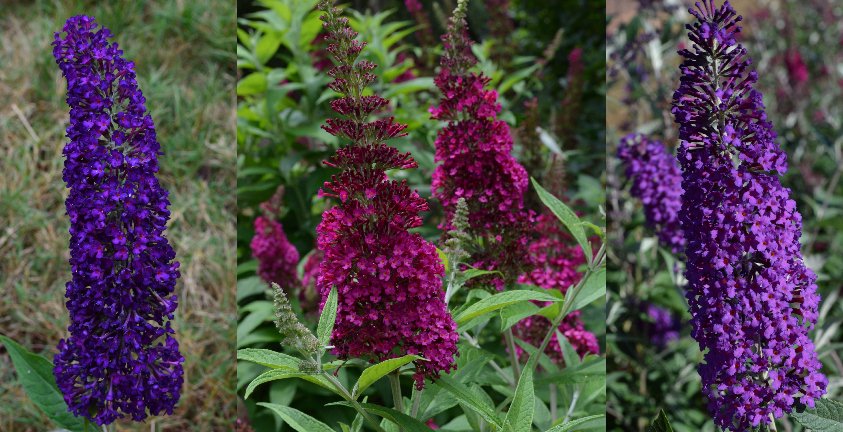 New Buddlejas Groovy Grape (left), Funky Fuchsia (centre), and Psychedelic Sky (right).
|
Last year I came to believe that the plant labelled as Buddleja caryopteridifolia is in fact not that at all. The plant is widely sold and found in both National Collections: Longstock Nursery and The Lavender Garden. But this plant doesn't match the original botanical description of the species by William Wright Smith in 1914 nor that found in later reviews of the genus. Botanical illustrations clearly show a plant more like B. sterniana, and it is believed that the original specimens of the two species may have become confused at the Royal Botanical Gardens in Edinburgh (see Cotton, A. D. (1947) Spring flowering buddleias). The final piece of evidence came from John Chau, a graduate student at the Univerity of Washington working on Buddleja phylogeny - he sent me a photo of B. caryopteridifolia in its native China. Nothing like the cultivated plant. So that leaves a mystery as to what the cultivated plant might be. I would hazard a guess that it is B. x wardii, a naturally occuring hybrid of a B. crispa species and B. alternifolia, especially given its propensity for occassional shoots with alternate leaves and the scent of the flowers that is very like B. alternifolia. I don't have the authority to unilaterally relabel the plant, so for now I am stuck calling it by the wrong name. | |
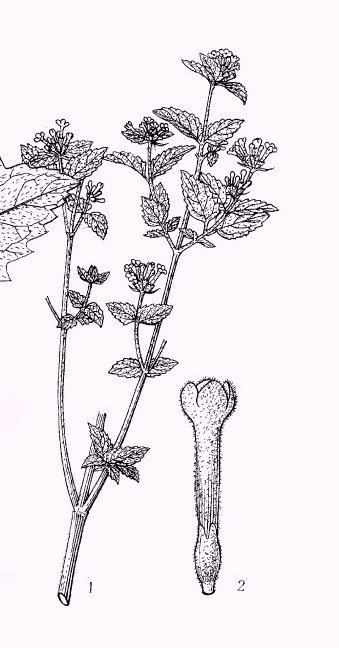
| 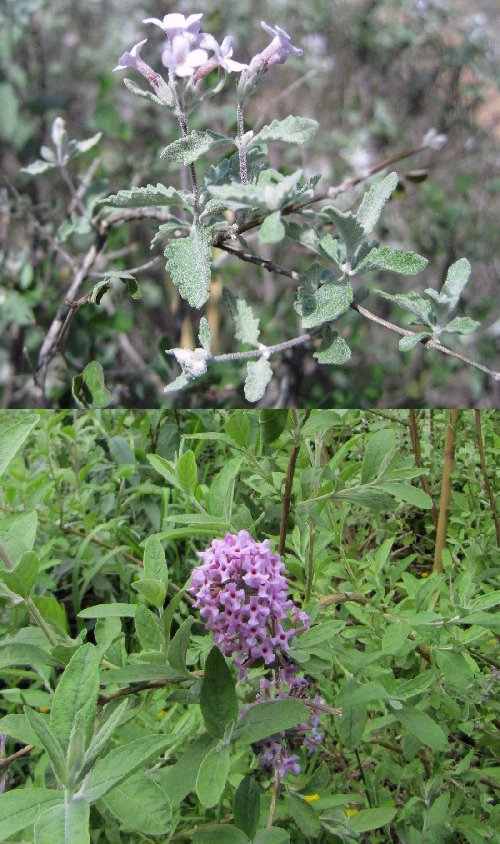
|
